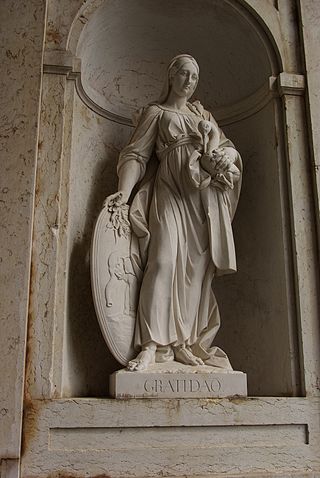The Hebrew alphabet, known variously by scholars as the Ktav Ashuri, Jewish script, square script and block script, is an abjad script used in the writing of the Hebrew language and other Jewish languages, most notably Yiddish, Ladino, Judeo-Arabic, and Judeo-Persian. It is also used informally in Israel to write Levantine Arabic, especially among Druze. It is an offshoot of the Imperial Aramaic alphabet, which flourished during the Achaemenid Empire and which itself derives from the Phoenician alphabet.
The system of Hebrew numerals is a quasi-decimal alphabetic numeral system using the letters of the Hebrew alphabet. The system was adapted from that of the Greek numerals in the late 2nd century BCE.

A letter is a written message conveyed from one person to another through a medium. Something epistolary means that it is a form of letter writing. The term usually excludes written material intended to be read in its original form by large numbers of people, such as newspapers and placards, although even these may include material in the form of an "open letter". The typical form of a letter for many centuries, and the archetypal concept even today, is a sheet of paper that is sent to a correspondent through a postal system. A letter can be formal or informal, depending on its audience and purpose. Besides being a means of communication and a store of information, letter writing has played a role in the reproduction of writing as an art throughout history. Letters have been sent since antiquity and are mentioned in the Iliad. Historians Herodotus and Thucydides mention and use letters in their writings.

The Second Epistle to the Thessalonians is a book from the New Testament of the Christian Bible. It is traditionally attributed to Paul the Apostle, with Timothy as a co-author. Modern biblical scholarship is divided on whether the epistle was written by Paul; some scholars believe Paul wrote this epistle, but others reject its authenticity based on what they see as differences in style and theology between this and the First Epistle to the Thessalonians.
Although people in many parts of the world share common alphabets and numeral systems, styles of handwritten letterforms vary between individuals, and sometimes also vary systematically between regions.

Secure Digital, officially abbreviated as SD, is a proprietary non-volatile flash memory card format developed by the SD Association (SDA) for use in portable devices.

Cursive is any style of penmanship in which characters are written joined in a flowing manner, generally for the purpose of making writing faster, in contrast to block letters. It varies in functionality and modern-day usage across languages and regions; being used both publicly in artistic and formal documents as well as in private communication. Formal cursive is generally joined, but casual cursive is a combination of joins and pen lifts. The writing style can be further divided as "looped", "italic" or "connected".

Letter case is the distinction between the letters that are in larger uppercase or capitals and smaller lowercase in the written representation of certain languages. The writing systems that distinguish between the upper and lowercase have two parallel sets of letters, with each letter in one set usually having an equivalent in the other set. The two case variants are alternative representations of the same letter: they have the same name and pronunciation and are treated identically when sorting in alphabetical order.
Dysgraphia is a learning disability of written expression, which affects the ability to write, primarily handwriting, but also coherence. It is a specific learning disability (SLD) as well as a transcription disability, meaning that it is a writing disorder associated with impaired handwriting, orthographic coding and finger sequencing. It often overlaps with other learning disabilities and neurodevelopmental disorders such as speech impairment, attention deficit hyperactivity disorder (ADHD) or developmental coordination disorder (DCD).

In typography, all caps refers to text or a font in which all letters are capital letters, for example: "THIS TEXT IS IN ALL CAPS". All caps may be used for emphasis. They are commonly seen in legal documents, the titles on book covers, in advertisements and in newspaper headlines. Short strings of words in capital letters appear bolder and "louder" than mixed case, and this is sometimes referred to as "screaming" or "shouting". All caps can also be used to indicate that a given word is an acronym.

Gratitude, thankfulness, or gratefulness is a feeling of appreciation by a recipient of another's kindness. This kindness can be gifts, help, favors, or another form of generosity to another person.

Note-taking is the practice of recording information from different sources and platforms. By taking notes, the writer records the essence of the information, freeing their mind from having to recall everything. Notes are commonly drawn from a transient source, such as an oral discussion at a meeting, or a lecture, in which case the notes may be the only record of the event. Since the advent of writing and literacy, notes traditionally were almost always handwritten, but the introduction of notetaking software has made digital notetaking possible and widespread. Note-taking is a foundational skill in personal knowledge management.

Russian cursive is a variant of the Russian alphabet used for writing by hand. It is typically referred to as (ру́сский) рукопи́сный шрифт (rússky) rukopísny shrift, "(Russian) handwritten font". It is the handwritten form of the modern Russian Cyrillic script, used instead of the block letters seen in printed material. In addition, Russian italics for lowercase letters are often based on Russian cursive. Most handwritten Russian, especially in personal letters and schoolwork, uses the cursive alphabet. In Russian schools most children are taught from first grade how to write with this script.
Informal or ad hoc romanizations of Cyrillic have been in use since the early days of electronic communications, starting from early e-mail and bulletin board systems. Their use faded with the advances in the Russian internet that made support of Cyrillic script standard, but resurfaced with the proliferation of instant messaging, SMS and mobile phone messaging in Russia.
Ugandan English, or Uglish, is the variety of English spoken in Uganda. The term Uglish is first recorded in 2012. Other colloquial portmanteau words are Uganglish and Ugandlish (2010).
Shukr is an Arabic term denoting thankfulness, gratitude or acknowledgment by humans, being a highly esteemed virtue in Islam. The term may also be used if the subject is God, in which case it takes the meaning of "divine responsiveness".
As the use of letters increased in popularity, guides began to emerge on how to correctly write and form a letter and as to what was proper, and what was not. Many of these Victorian conventions are a way of understanding tensions in nineteenth-century England, such as the urge to speak from the heart, but never more than was proper.
A dedication or book dedication is the expression of friendly connection or thanks by the author towards another person. The dedication has its own place on the dedication page and is part of the front matter.
Harald Geisler is an artist known for his typographic projects about the role of writing in society. He was born 1980 in Frankfurt am Main, Germany and graduated in 2009 at the University of Art and Design Offenbach am Main.

"Thank you" is a common expression of gratitude in the English language. The term itself originated as a shortened form of the expression "I thank you".










